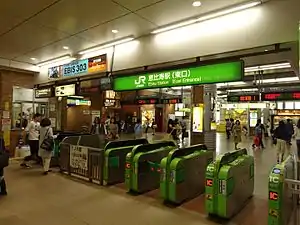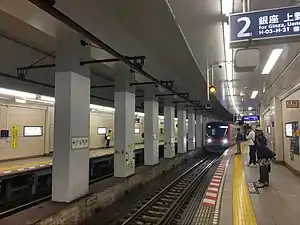Ebisu Station (Tokyo)
Ebisu Station (恵比寿駅, Ebisu-eki) is a railway station in the Ebisu neighborhood of Tokyo's Shibuya ward, operated by East Japan Railway Company (JR East) and the Tokyo subway operator Tokyo Metro. The station is named after Yebisu Beer, which was once brewed in an adjacent brewery, and which is itself named for the Japanese deity Ebisu.
Ebisu Station 恵比寿駅 | |
|---|---|
 Statue outside Ebisu station | |
| Location | Shibuya, Tokyo Japan |
| Coordinates | 35°38′48″N 139°42′36″E |
| Operated by | |
Lines
Ebisu is served by the following lines:
- East Japan Railway Company (JR East)
- Yamanote Line
- Saikyō Line
- Shōnan-Shinjuku Line
- Tokyo Metro
JR East station
EBSJA09JS18JY21 Ebisu Station 恵比寿駅 | |||||||||||||||||||||
|---|---|---|---|---|---|---|---|---|---|---|---|---|---|---|---|---|---|---|---|---|---|
| JR East station | |||||||||||||||||||||
 JR station entrance in May 2016 | |||||||||||||||||||||
| Location | 1 Ebisu Minami, Shibuya-ku, Tokyo Japan | ||||||||||||||||||||
| Operated by | |||||||||||||||||||||
| Line(s) |
| ||||||||||||||||||||
| Platforms | 2 island platforms | ||||||||||||||||||||
| Tracks | 4 | ||||||||||||||||||||
| History | |||||||||||||||||||||
| Opened | 1906 | ||||||||||||||||||||
| Passengers | |||||||||||||||||||||
| FY2019 | 145,805 daily | ||||||||||||||||||||
| Services | |||||||||||||||||||||
| |||||||||||||||||||||
Platforms
The JR East station consists of two island platforms serving four tracks.
| 1 | JY Yamanote Line | for Shibuya, Shinjuku, and Ikebukuro |
| 2 | JY Yamanote Line | for Shinagawa, Tokyo, and Ueno |
| 3 | JA Saikyo Line | for Shinjuku, Ikebukuro, and Ōmiya |
| JS Shōnan-Shinjuku Line | for Ōmiya, Utsunomiya, and Takasaki | |
| 4 | JA Saikyō Line | for Ōsaki R Rinkai Line for Shin-Kiba |
| JS Shōnan-Shinjuku Line | for Yokohama, Ōfuna,Odawara, and Zushi |
 Platforms 1 and 2
Platforms 1 and 2 Platforms 3 and 4
Platforms 3 and 4
Station melody
The melody known as "The Third Man Theme" (or as the "Ebisu Theme" in Japan) is played at the platforms just prior to train departures. This melody was used in Ebisu beer TV commercials. Most of the many of thousands of people who pass through the station each day probably do not realize that the song was made famous by the 1949 Orson Welles film noir, The Third Man, written by Graham Greene and featuring a very dark subject matter, the sale of fake penicillin in post-World War Vienna. The song, played on the zither by the previously unknown Austrian musician, Anton Karas, was a huge international hit in 1949 and 1950.
Tokyo Metro station
H02 Ebisu Station 恵比寿駅 | ||||||||||||||||
|---|---|---|---|---|---|---|---|---|---|---|---|---|---|---|---|---|
| Tokyo Metro station | ||||||||||||||||
 Hibiya Line platforms in 2019 | ||||||||||||||||
| Location | 1-5-5 Ebisu Minami, Shibuya-ku, Tokyo Japan | |||||||||||||||
| Operated by | ||||||||||||||||
| Line(s) | H Tokyo Metro Hibiya Line | |||||||||||||||
| Platforms | 2 side platforms | |||||||||||||||
| Tracks | 2 | |||||||||||||||
| Other information | ||||||||||||||||
| Station code | H-02 | |||||||||||||||
| History | ||||||||||||||||
| Opened | 1964 | |||||||||||||||
| Passengers | ||||||||||||||||
| FY2019 | 117,796 daily | |||||||||||||||
| Services | ||||||||||||||||
| ||||||||||||||||
Platforms
The subway station has two side platforms serving two tracks.
| 1 | H Tokyo Metro Hibiya Line | for Naka-Meguro |
| 2 | H Tokyo Metro Hibiya Line | for Roppongi, Ginza, Ueno, and Kita-senju TS Tobu Skytree Line for Tōbu-Dōbutsu-Kōen TN Tobu Nikko Line for Minami-Kurihashi |
History
The station first opened in 1901 as a freight terminal for the neighboring Yebisu Beer factory. Passenger trains began to stop at the station on 30 September 1906.[1] The Tokyo Tamagawa tram line was extended to the station in 1927. In May 1945, the station building burned to the ground amid the bombing of Tokyo. The subway station opened on 25 March 1964[2] and the tram service was discontinued in 1967.
The Sapporo Brewery at Ebisu and its accompanying rail freight terminal were closed in 1982. The space was used for a "car train" service for several years before being redeveloped as the Ebisu Garden Place high-rise complex.
The Saikyo Line was extended to Ebisu in 1996. Through service to the Shonan-Shinjuku Line began in 2001, and to the Rinkai Line in 2002. Between 1996 and 2002, Ebisu served as the southern passenger terminus of the Saikyo Line, with Osaki Station being used as a turnaround point but not having passenger platforms connected to the line.
 Old TRTA logo above station entrance, March 2004
Old TRTA logo above station entrance, March 2004
Chest-height platform edge doors were introduced on the two Yamanote Line platforms from 26 June 2010, the first time that such doors were installed on a JR line other than the Shinkansen.[3][4]
Passenger statistics
In fiscal 2019, the JR East station was used by 145,805 passengers daily (boarding passengers only), making it the 20th-busiest station operated by JR East.[5] In fiscal 2019, the Tokyo Metro station was used by an average of 117,796 passengers per day (exiting and entering passengers), making it the 30th-busiest station operated by Tokyo Metro.[6]
The daily passenger figures for each operator in previous years are as shown below.
| Fiscal year | JR East | Tokyo Metro |
|---|---|---|
| 1999 | 129,081[7] | |
| 2000 | 127,967[8] | |
| 2005 | 131,507[9] | |
| 2010 | 130,245[10] | |
| 2011 | 128,555[11] | |
| 2012 | 130,241[12] | 98,217[13] |
| 2013 | 133,553[14] | 104,738[15] |
| 2014 | 135,493[16] | 107,471 [17] |
| 2015 | 139,882[18] | 111,149[19] |
| 2016 | 143,898[20] | 115,726[21] |
| 2017 | 145,319[22] | 118,260[23] |
| 2018 | 147,699[24] | 119,939[25] |
| 2019 | 145,805[5] | 117,796[6] |
- Note that JR East figures are for boarding passengers only.
See also
References
- JR East /info.aspx?StationCd=290 JR East Ebisu Station information Retrieved 4 March 2010. (in Japanese)
- Terada, Hirokazu (July 2002). データブック日本の私鉄 [Databook: Japan's Private Railways]. Japan: Neko Publishing. ISBN 4-87366-874-3.
- JR East press release: "山手線恵比寿駅、目黒駅のホームドア使用開始日について" (Introduction of platform doors at Yamanote Line Ebisu and Meguro Stations) (4 March 2010). Retrieved 4 March 2010. (in Japanese)
- "山手線恵比寿駅でホーム可動柵の使用を開始 (Platform doors enter operation at Yamanote Line Ebisu Station)". Japan Railfan Magazine (in Japanese). Koyusha Co., Ltd. 27 June 2010. Retrieved 28 June 2010.
- 各駅の乗車人員(2019年度) [Station passenger figures (Fiscal 2019)] (in Japanese). Japan: East Japan Railway Company. Archived from the original on 14 January 2021. Retrieved 14 January 2021.
- 各駅の乗降人員ランキング [Station usage ranking] (in Japanese). Tokyo Metro. Archived from the original on 10 January 2021. Retrieved 14 January 2021.
- 各駅の乗車人員(1999年度) [Station passenger figures (Fiscal 1999)] (in Japanese). Japan: East Japan Railway Company. Retrieved 6 September 2014.
- 各駅の乗車人員(2000年度) [Station passenger figures (Fiscal 2000)] (in Japanese). Japan: East Japan Railway Company. Archived from the original on 9 October 2014. Retrieved 6 September 2014.
- 各駅の乗車人員(2005年度) [Station passenger figures (Fiscal 2005)] (in Japanese). Japan: East Japan Railway Company. Archived from the original on 9 October 2014. Retrieved 6 September 2014.
- 各駅の乗車人員 (2010年度) [Station passenger figures (Fiscal 2010)] (in Japanese). Japan: East Japan Railway Company. Archived from the original on 6 October 2014. Retrieved 6 September 2014.
- 各駅の乗車人員(2011年度) [Station passenger figures (Fiscal 2011)] (in Japanese). Japan: East Japan Railway Company. Archived from the original on 8 October 2014. Retrieved 6 September 2014.
- 各駅の乗車人員(2012年度) [Station passenger figures (Fiscal 2012)] (in Japanese). Japan: East Japan Railway Company. Archived from the original on 7 October 2014. Retrieved 6 September 2014.
- 各駅の乗降人員ランキング (2012年) [Station usage ranking (2012)] (in Japanese). Tokyo Metro. Archived from the original on 14 January 2021. Retrieved 14 January 2021.
- 各駅の乗車人員(2013年度) [Station passenger figures (Fiscal 2013)] (in Japanese). Japan: East Japan Railway Company. Archived from the original on 14 January 2021. Retrieved 14 January 2021.
- 各駅の乗降人員ランキング (2013年) [Station usage ranking (2013)] (in Japanese). Tokyo Metro. Archived from the original on 14 January 2021. Retrieved 14 January 2021.
- 各駅の乗車人員(2014年度) [Station passenger figures (Fiscal 2014)] (in Japanese). Japan: East Japan Railway Company. Archived from the original on 1 January 2021. Retrieved 14 January 2021.
- 各駅の乗降人員ランキング (2014年) [Station usage ranking (2014)] (in Japanese). Tokyo Metro. Archived from the original on 14 January 2021. Retrieved 14 January 2021.
- 各駅の乗車人員(2015年度) [Station passenger figures (Fiscal 2015)] (in Japanese). Japan: East Japan Railway Company. Archived from the original on 11 January 2021. Retrieved 14 January 2021.
- 各駅の乗降人員ランキング (2015年) [Station usage ranking (2015)] (in Japanese). Tokyo Metro. Archived from the original on 28 October 2020. Retrieved 14 January 2021.
- 各駅の乗車人員(2016年度) [Station passenger figures (Fiscal 2016)] (in Japanese). Japan: East Japan Railway Company. Archived from the original on 12 January 2021. Retrieved 14 January 2021.
- 各駅の乗降人員ランキング (2016年) [Station usage ranking (2016)] (in Japanese). Tokyo Metro. Archived from the original on 14 January 2021. Retrieved 14 January 2021.
- 各駅の乗車人員(2017年度) [Station passenger figures (Fiscal 2017)] (in Japanese). Japan: East Japan Railway Company. Archived from the original on 1 January 2021. Retrieved 14 January 2021.
- 各駅の乗降人員ランキング (2017年) [Station usage ranking (2017)] (in Japanese). Tokyo Metro. Archived from the original on 14 January 2021. Retrieved 14 January 2021.
- 各駅の乗車人員(2018年度) [Station passenger figures (Fiscal 2018)] (in Japanese). Japan: East Japan Railway Company. Archived from the original on 1 January 2021. Retrieved 14 January 2021.
- 各駅の乗降人員ランキング (2018年) [Station usage ranking (2018)] (in Japanese). Tokyo Metro. Archived from the original on 14 January 2021. Retrieved 14 January 2021.
External links
| Wikimedia Commons has media related to Ebisu Station (Tokyo). |
- JR East Ebisu Station information (in English)
- JR East Ebisu Station information (in Japanese)
- Tokyo Metro Ebisu Station information (in English)
- Tokyo Metro Ebisu Station information (in Japanese)
